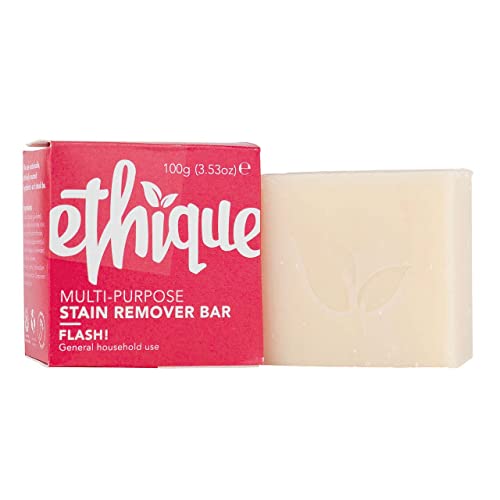
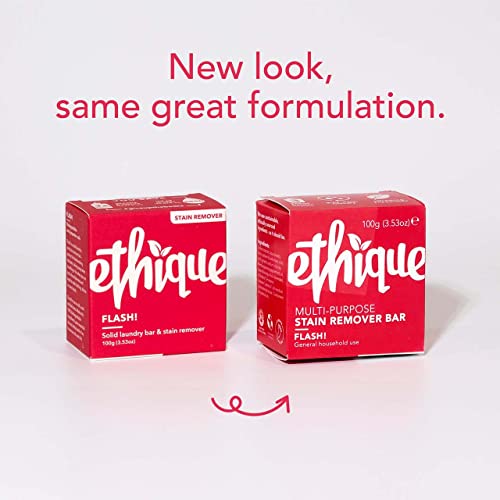
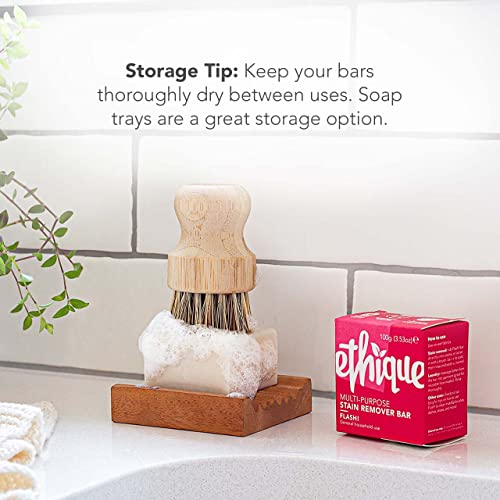
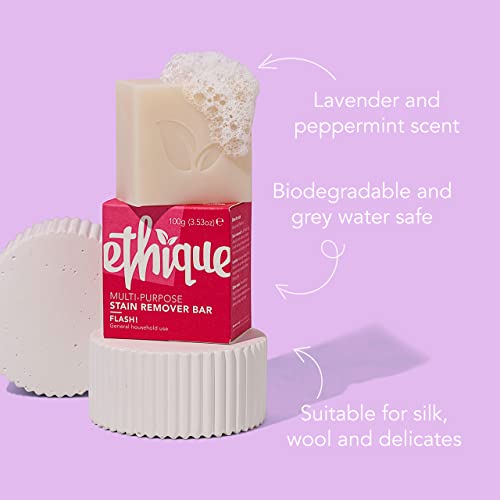
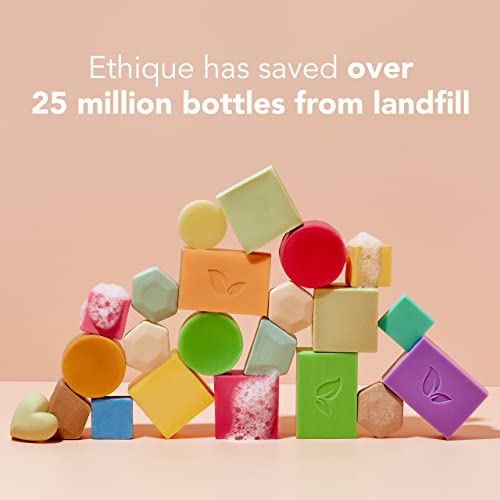
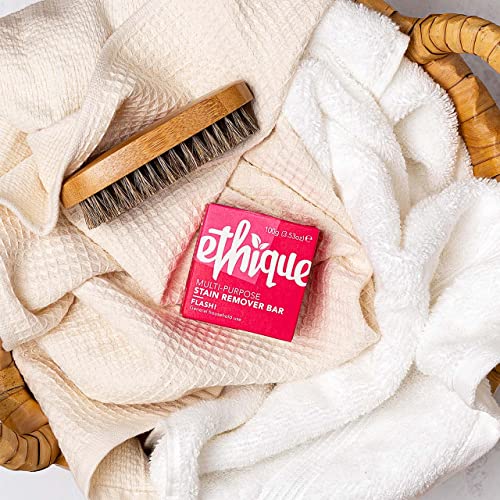
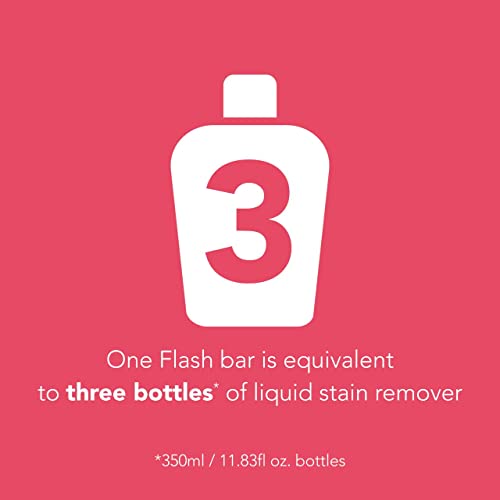
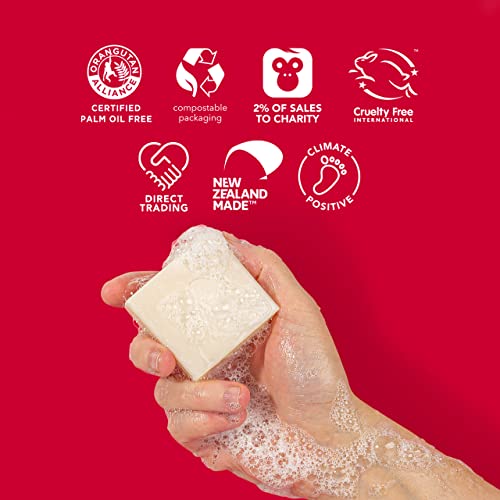
Ethique Flash! Solid Laundry Bar - Biodegradable, Vegan, Plastic-Free - 3.52 oz


Coumarin
High RiskCoumarin is a naturally occurring and synthetic compound found in many plants. It is commonly used in fragrances, flavorings, and as a potential therapeutic agent due to its aromatic properties. Coumarin has applications in cosmetics and personal care products, contributing to their scent and stability.
Sustai Insights
Coumarin offers functional benefits as a fragrance and flavoring agent, with potential health benefits in certain therapeutic contexts. However, it is associated with high allergenic potential and may pose risks such as skin irritation. Environmental concerns include its classification as a pollutant, with possible bioaccumulation effects. Regulatory bodies have restricted its use in specific products, indicating a moderate to high risk overall. Safe usage practices are advised, and alternatives like natural essential oils could be considered.
Linalool
High RiskLinalool is a terpene commonly found in various plants, particularly in lavender and mint. It is primarily used in products for its fragrance and potential antimicrobial properties. Linalool is also utilized in formulations for its ability to enhance the sensory experience of personal care and household products.
Sustai Insights
Linalool offers functional benefits as a naturally occurring fragrance component and may exhibit antimicrobial properties. However, it presents high allergenic potential, with concerns about skin irritation and sensitization. Environmental risks include contamination issues, though it is not classified as a persistent pollutant. Regulatory bodies have noted the need for careful handling due to its allergenic nature. Overall, despite some beneficial attributes, the ingredient carries a high risk profile, warranting cautious use and consideration of safer alternatives.
Tetrasodium Etidronate
High RiskTetrasodium etidronate is a diphosphonic acid used primarily as a chelating agent in various products. It functions to bind metal ions, thereby preventing the adverse effects of hardness in water and improving product stability. This ingredient is often found in personal care and household products.
Sustai Insights
Tetrasodium etidronate effectively acts as a chelating agent, enhancing product performance by improving stability and preventing metal ion interference. However, it is associated with high use restrictions, potential skin irritation, and is considered to have low risk for carcinogenicity and allergies. Regulatory agencies have advised caution, with its environmental profile indicating potential pollution risks. Overall, while it serves functional benefits, the high-risk assessment suggests careful consideration of its use in formulations, with safer alternatives recommended where possible.
D Limonene
Medium RiskD-limonene is a colorless liquid hydrocarbon classified as a terpene. It is primarily derived from citrus fruit peels and is commonly used in fragrances, cleaning products, and as a solvent due to its pleasant scent and ability to dissolve oils.
Sustai Insights
D-limonene serves as an effective solvent and fragrance, with biodegradable properties suggesting some environmental sustainability. However, it poses a high allergenic potential, with possible skin and respiratory irritations. Moderately persistent and bioaccumulative, it raises concerns about environmental impact. Regulatory bodies have noted restrictions on its use due to these risks. Overall, it presents a medium risk level, necessitating safe usage practices and consideration of alternatives like plant-based solvents.
Citric Acid
Medium RiskCitric acid is an alpha hydroxy acid used in personal care products primarily for its role as a pH adjuster and natural preservative. It occurs naturally in citrus fruits and is commonly utilized in various formulations for its chelating properties and mild exfoliation benefits.
Sustai Insights
Citric acid offers functional benefits as an effective preservative and pH stabilizer, contributing to product longevity and stability. It is biodegradable and derived from renewable sources. Health risks are low, with minimal concerns regarding carcinogenicity, allergies, and reproductive toxicity. However, moderate use restrictions exist due to potential irritation at high concentrations. Environmental risks are limited, as citric acid is not known to accumulate in ecosystems. Regulatory agencies have no significant advisories against its use. Overall, it is assessed as a medium-risk ingredient, with safe usage practices recommended and alternatives available.
Pentasodium Dtpa
Low RiskPentasodium DTPA is a chelating agent used in cosmetic formulations to bind metal ions, enhancing product stability and efficacy. It helps prevent the degradation of active ingredients by sequestering harmful metals, thereby extending shelf life and improving performance in various formulations.
Sustai Insights
Pentasodium DTPA offers functional benefits as an effective chelating agent, contributing to product stability and preventing metal ion interference. It has a low risk of health concerns, with low associations for carcinogenicity and allergies; however, there are moderate concerns regarding developmental and reproductive toxicity. Environmentally, it poses minimal risks, as it is not bioaccumulative. Regulatory bodies have not imposed significant restrictions. Overall, it is assessed as low risk, making it a relatively safe choice in cosmetic formulations. Alternatives could include other chelating agents like sodium phytate.
Coconut Fatty Acid
Low RiskCoconut fatty acid is a mixture of fatty acids derived from coconut oil, primarily composed of caprylic and capric acids. It is commonly used in cosmetic formulations for its emollient properties, helping to moisturize and soften the skin.
Sustai Insights
Coconut fatty acid serves as an effective emollient, enhancing skin hydration and texture. It is considered to have low health risks, with minimal concerns regarding carcinogenicity, allergenic potential, and reproductive toxicity. Environmentally, it is not recognized as a pollutant or bioaccumulative. Regulatory bodies do not impose significant restrictions on its use. Overall, the ingredient poses low risk, and its safe application in cosmetic products is supported by its favorable profile.
Lavandula Angustifolia (Lavender) Flower Oil
Low RiskLavandula angustifolia (lavender) flower oil is an essential oil derived from the flowers of the lavender plant. It is commonly used in personal care products for its aromatic properties and is known for its potential soothing effects in formulations.
Sustai Insights
Lavender oil provides functional benefits such as fragrance enhancement and potential calming effects, contributing to user experience in various personal care products. It is sustainably sourced and has low toxicity levels. Health risks associated with lavender oil are minimal, with low concerns for carcinogenicity, allergies, and reproductive toxicity. Environmental risks are also low, with no significant pollutant concerns. Regulatory assessments indicate no current restrictions, affirming its safety for use. Overall, the ingredient is considered low risk, making it a favorable choice in formulations.
Mentha Piperita (Peppermint) Oil Extract
Low RiskMentha piperita (peppermint) oil extract is derived from the peppermint plant and is commonly used in various products for its aromatic and flavoring properties. It serves multiple functions, including acting as a fragrance agent and providing a cooling sensation in topical applications.
Sustai Insights
Mentha piperita oil offers functional benefits such as flavor enhancement and a refreshing aroma, while it is generally recognized as low risk for health concerns, including carcinogenicity and allergies. Environmentally, it does not contribute significantly to pollution or bioaccumulation. Regulatory bodies do not impose restrictions on its use. Safe usage practices include avoiding excessive exposure, particularly for sensitive individuals. Alternatives like spearmint oil may be considered, but overall, this ingredient is assessed as low risk.
Vegetarian Glycerin
Low RiskVegetarian glycerin, also known as glycerol, is a colorless, odorless, and viscous liquid derived from plant sources. It is primarily used as a humectant, solvent, and emollient in various personal care products, helping to retain moisture and improve texture.
Sustai Insights
Vegetarian glycerin offers functional benefits as an effective humectant, promoting hydration and skin smoothness. It is biodegradable and typically sustainably sourced. Health risks associated with glycerin are low, with no significant concerns for carcinogenicity, allergens, or reproductive toxicity. Environmental risks are minimal, and it is not subject to major regulatory warnings. Overall, the risk level for this ingredient is low, making it a safe choice in formulations. Safe usage practices include ensuring proper concentrations in products, and alternatives such as propylene glycol exist but may have differing properties.
Sodium Cocoate
Low RiskSodium cocoate is the sodium salt of fatty acids derived from coconut oil. It is primarily used in cosmetic formulations as a surfactant and cleansing agent, effectively helping to emulsify oils and fats, contributing to the overall texture and performance of the product.
Sustai Insights
Sodium cocoate acts as an effective surfactant and cleansing agent, offering functional benefits in personal care products. It is biodegradable and derived from renewable sources, contributing to sustainability. Health risks are low, as it is not associated with carcinogenicity, significant allergenic potential, or reproductive toxicity. However, it may cause mild irritation to skin, eyes, or lungs. Regulatory bodies have not imposed significant restrictions, affirming its safety for use. Overall, it presents a low-risk profile, making it a suitable choice in formulations.
Water
Low RiskWater is a clear, colorless liquid essential for various biological processes. It serves as a solvent in formulations, facilitating the dissolution of other ingredients and enhancing product texture and application. Additionally, water plays a crucial role in hydration and is a key component in many cosmetic and personal care products.
Sustai Insights
Water is an effective solvent and hydrator, contributing to the texture and efficacy of formulations. It is biodegradable and generally regarded as safe, with low concerns regarding carcinogenicity, allergies, and reproductive toxicity. However, excessive water usage can lead to environmental concerns, particularly regarding resource depletion. Regulatory bodies do not impose restrictions on water use in cosmetics. Overall, the risks associated with water are low, making it a safe and essential ingredient.
Kaolin
Low RiskKaolin is a clay mineral composed of hydrated aluminum silicate. It is commonly used in various products for its absorbent properties, acting as a thickener, filler, and anti-caking agent in cosmetics, pharmaceuticals, and food applications.
Sustai Insights
Kaolin offers functional benefits such as effective absorption and thickening, making it valuable in personal care and industrial products. It is generally considered safe, with low concerns related to carcinogenicity, allergies, and reproductive toxicity. Environmental risks are minimal, as it is not known to be a pollutant or bioaccumulative. Regulatory bodies impose few restrictions, underscoring its low-risk profile. Safe usage practices are recommended, and while alternatives exist, kaolin remains a low-risk option in its applications.
Coumarin
High RiskCoumarin is a naturally occurring and synthetic compound found in many plants. It is commonly used in fragrances, flavorings, and as a potential therapeutic agent due to its aromatic properties. Coumarin has applications in cosmetics and personal care products, contributing to their scent and stability.
Sustai Insights
Coumarin offers functional benefits as a fragrance and flavoring agent, with potential health benefits in certain therapeutic contexts. However, it is associated with high allergenic potential and may pose risks such as skin irritation. Environmental concerns include its classification as a pollutant, with possible bioaccumulation effects. Regulatory bodies have restricted its use in specific products, indicating a moderate to high risk overall. Safe usage practices are advised, and alternatives like natural essential oils could be considered.
Pentasodium Dtpa
Low RiskPentasodium DTPA is a chelating agent used in cosmetic formulations to bind metal ions, enhancing product stability and efficacy. It helps prevent the degradation of active ingredients by sequestering harmful metals, thereby extending shelf life and improving performance in various formulations.
Sustai Insights
Pentasodium DTPA offers functional benefits as an effective chelating agent, contributing to product stability and preventing metal ion interference. It has a low risk of health concerns, with low associations for carcinogenicity and allergies; however, there are moderate concerns regarding developmental and reproductive toxicity. Environmentally, it poses minimal risks, as it is not bioaccumulative. Regulatory bodies have not imposed significant restrictions. Overall, it is assessed as low risk, making it a relatively safe choice in cosmetic formulations. Alternatives could include other chelating agents like sodium phytate.
Coconut Fatty Acid
Low RiskCoconut fatty acid is a mixture of fatty acids derived from coconut oil, primarily composed of caprylic and capric acids. It is commonly used in cosmetic formulations for its emollient properties, helping to moisturize and soften the skin.
Sustai Insights
Coconut fatty acid serves as an effective emollient, enhancing skin hydration and texture. It is considered to have low health risks, with minimal concerns regarding carcinogenicity, allergenic potential, and reproductive toxicity. Environmentally, it is not recognized as a pollutant or bioaccumulative. Regulatory bodies do not impose significant restrictions on its use. Overall, the ingredient poses low risk, and its safe application in cosmetic products is supported by its favorable profile.
Lavandula Angustifolia (Lavender) Flower Oil
Low RiskLavandula angustifolia (lavender) flower oil is an essential oil derived from the flowers of the lavender plant. It is commonly used in personal care products for its aromatic properties and is known for its potential soothing effects in formulations.
Sustai Insights
Lavender oil provides functional benefits such as fragrance enhancement and potential calming effects, contributing to user experience in various personal care products. It is sustainably sourced and has low toxicity levels. Health risks associated with lavender oil are minimal, with low concerns for carcinogenicity, allergies, and reproductive toxicity. Environmental risks are also low, with no significant pollutant concerns. Regulatory assessments indicate no current restrictions, affirming its safety for use. Overall, the ingredient is considered low risk, making it a favorable choice in formulations.
Mentha Piperita (Peppermint) Oil Extract
Low RiskMentha piperita (peppermint) oil extract is derived from the peppermint plant and is commonly used in various products for its aromatic and flavoring properties. It serves multiple functions, including acting as a fragrance agent and providing a cooling sensation in topical applications.
Sustai Insights
Mentha piperita oil offers functional benefits such as flavor enhancement and a refreshing aroma, while it is generally recognized as low risk for health concerns, including carcinogenicity and allergies. Environmentally, it does not contribute significantly to pollution or bioaccumulation. Regulatory bodies do not impose restrictions on its use. Safe usage practices include avoiding excessive exposure, particularly for sensitive individuals. Alternatives like spearmint oil may be considered, but overall, this ingredient is assessed as low risk.
Vegetarian Glycerin
Low RiskVegetarian glycerin, also known as glycerol, is a colorless, odorless, and viscous liquid derived from plant sources. It is primarily used as a humectant, solvent, and emollient in various personal care products, helping to retain moisture and improve texture.
Sustai Insights
Vegetarian glycerin offers functional benefits as an effective humectant, promoting hydration and skin smoothness. It is biodegradable and typically sustainably sourced. Health risks associated with glycerin are low, with no significant concerns for carcinogenicity, allergens, or reproductive toxicity. Environmental risks are minimal, and it is not subject to major regulatory warnings. Overall, the risk level for this ingredient is low, making it a safe choice in formulations. Safe usage practices include ensuring proper concentrations in products, and alternatives such as propylene glycol exist but may have differing properties.
Linalool
High RiskLinalool is a terpene commonly found in various plants, particularly in lavender and mint. It is primarily used in products for its fragrance and potential antimicrobial properties. Linalool is also utilized in formulations for its ability to enhance the sensory experience of personal care and household products.
Sustai Insights
Linalool offers functional benefits as a naturally occurring fragrance component and may exhibit antimicrobial properties. However, it presents high allergenic potential, with concerns about skin irritation and sensitization. Environmental risks include contamination issues, though it is not classified as a persistent pollutant. Regulatory bodies have noted the need for careful handling due to its allergenic nature. Overall, despite some beneficial attributes, the ingredient carries a high risk profile, warranting cautious use and consideration of safer alternatives.
D Limonene
Medium RiskD-limonene is a colorless liquid hydrocarbon classified as a terpene. It is primarily derived from citrus fruit peels and is commonly used in fragrances, cleaning products, and as a solvent due to its pleasant scent and ability to dissolve oils.
Sustai Insights
D-limonene serves as an effective solvent and fragrance, with biodegradable properties suggesting some environmental sustainability. However, it poses a high allergenic potential, with possible skin and respiratory irritations. Moderately persistent and bioaccumulative, it raises concerns about environmental impact. Regulatory bodies have noted restrictions on its use due to these risks. Overall, it presents a medium risk level, necessitating safe usage practices and consideration of alternatives like plant-based solvents.
Tetrasodium Etidronate
High RiskTetrasodium etidronate is a diphosphonic acid used primarily as a chelating agent in various products. It functions to bind metal ions, thereby preventing the adverse effects of hardness in water and improving product stability. This ingredient is often found in personal care and household products.
Sustai Insights
Tetrasodium etidronate effectively acts as a chelating agent, enhancing product performance by improving stability and preventing metal ion interference. However, it is associated with high use restrictions, potential skin irritation, and is considered to have low risk for carcinogenicity and allergies. Regulatory agencies have advised caution, with its environmental profile indicating potential pollution risks. Overall, while it serves functional benefits, the high-risk assessment suggests careful consideration of its use in formulations, with safer alternatives recommended where possible.
Sodium Cocoate
Low RiskSodium cocoate is the sodium salt of fatty acids derived from coconut oil. It is primarily used in cosmetic formulations as a surfactant and cleansing agent, effectively helping to emulsify oils and fats, contributing to the overall texture and performance of the product.
Sustai Insights
Sodium cocoate acts as an effective surfactant and cleansing agent, offering functional benefits in personal care products. It is biodegradable and derived from renewable sources, contributing to sustainability. Health risks are low, as it is not associated with carcinogenicity, significant allergenic potential, or reproductive toxicity. However, it may cause mild irritation to skin, eyes, or lungs. Regulatory bodies have not imposed significant restrictions, affirming its safety for use. Overall, it presents a low-risk profile, making it a suitable choice in formulations.
Water
Low RiskWater is a clear, colorless liquid essential for various biological processes. It serves as a solvent in formulations, facilitating the dissolution of other ingredients and enhancing product texture and application. Additionally, water plays a crucial role in hydration and is a key component in many cosmetic and personal care products.
Sustai Insights
Water is an effective solvent and hydrator, contributing to the texture and efficacy of formulations. It is biodegradable and generally regarded as safe, with low concerns regarding carcinogenicity, allergies, and reproductive toxicity. However, excessive water usage can lead to environmental concerns, particularly regarding resource depletion. Regulatory bodies do not impose restrictions on water use in cosmetics. Overall, the risks associated with water are low, making it a safe and essential ingredient.
Citric Acid
Medium RiskCitric acid is an alpha hydroxy acid used in personal care products primarily for its role as a pH adjuster and natural preservative. It occurs naturally in citrus fruits and is commonly utilized in various formulations for its chelating properties and mild exfoliation benefits.
Sustai Insights
Citric acid offers functional benefits as an effective preservative and pH stabilizer, contributing to product longevity and stability. It is biodegradable and derived from renewable sources. Health risks are low, with minimal concerns regarding carcinogenicity, allergies, and reproductive toxicity. However, moderate use restrictions exist due to potential irritation at high concentrations. Environmental risks are limited, as citric acid is not known to accumulate in ecosystems. Regulatory agencies have no significant advisories against its use. Overall, it is assessed as a medium-risk ingredient, with safe usage practices recommended and alternatives available.
Kaolin
Low RiskKaolin is a clay mineral composed of hydrated aluminum silicate. It is commonly used in various products for its absorbent properties, acting as a thickener, filler, and anti-caking agent in cosmetics, pharmaceuticals, and food applications.
Sustai Insights
Kaolin offers functional benefits such as effective absorption and thickening, making it valuable in personal care and industrial products. It is generally considered safe, with low concerns related to carcinogenicity, allergies, and reproductive toxicity. Environmental risks are minimal, as it is not known to be a pollutant or bioaccumulative. Regulatory bodies impose few restrictions, underscoring its low-risk profile. Safe usage practices are recommended, and while alternatives exist, kaolin remains a low-risk option in its applications.
Experience the power of Ethique Flash! Multi-Purpose Solid Laundry and Stain Remover Bar, a revolutionary plastic-free solution for your laundry needs. This eco-friendly, vegan, and cruelty-free detergent is designed to tackle tough stains while being gentle on the planet.
- Eco-Conscious Cleaning: Prevents 3 plastic bottles from entering landfills, making it a sustainable choice for laundry care.
- Travel-Friendly: Compact and lightweight, perfect for hand washing delicates or cleaning on the go—ideal for camping and travel.
- Natural Ingredients: Made with 100% biodegradable components and infused with pure essential oils, ensuring a fresh, pleasant scent.
- Effective Stain Removal: White Kaolin clay and sodium cocoate work together to lift dirt and oils, providing a deep clean without harsh chemicals.
- Lasting Value: Long-lasting formula that outperforms traditional detergents, saving you money and reducing environmental impact.
Join the movement toward a plastic-free future with Ethique, where every purchase contributes to a cleaner planet.
Subscribe & Save with Sustai
- Best Price Guarantee: Always enjoy the lowest prices on sustainable home essentials.
- No Surprises: We’ll notify you before shipping. No hidden fees, ever.
- You’re in Charge: Change, pause, or cancel your subscription anytime with ease.
- Eco-Friendly Deliveries: Our grouped shipments mean less packaging and lower emissions.
Join us on a sustainable journey. Special offers for a limited time! Prices and promotions may change.
Recommended Products
Experience the power of Ethique Flash! Multi-Purpose Solid Laundry and Stain Remover Bar, a revolutionary plastic-free solution for your laundry needs. This eco-friendly, vegan, and cruelty-free detergent is designed to tackle tough stains while being gentle on the planet.
- Eco-Conscious Cleaning: Prevents 3 plastic bottles from entering landfills, making it a sustainable choice for laundry care.
- Travel-Friendly: Compact and lightweight, perfect for hand washing delicates or cleaning on the go—ideal for camping and travel.
- Natural Ingredients: Made with 100% biodegradable components and infused with pure essential oils, ensuring a fresh, pleasant scent.
- Effective Stain Removal: White Kaolin clay and sodium cocoate work together to lift dirt and oils, providing a deep clean without harsh chemicals.
- Lasting Value: Long-lasting formula that outperforms traditional detergents, saving you money and reducing environmental impact.
Join the movement toward a plastic-free future with Ethique, where every purchase contributes to a cleaner planet.

You can have at most 2 Sustainable Steals products in your cart
Customer Reviews
Customers’ View
Customers appreciate the effectiveness and eco-friendly nature of the Ethique Flash Laundry Bar. Many users highlight its impressive stain removal capabilities, stating it effectively tackles dried-on stains and leaves no residue. The pleasant scent, derived from essential oils, is frequently praised for being refreshing without being overpowering. Travelers value the bar's compact size and lightweight design, making it convenient for on-the-go cleaning. Additionally, its biodegradable ingredients resonate well with environmentally conscious consumers, aligning with their values. Overall, customers find this product both effective and aligned with their sustainable lifestyle.
AI-generated from the text of customer reviewsThis product has no reviews yet.




